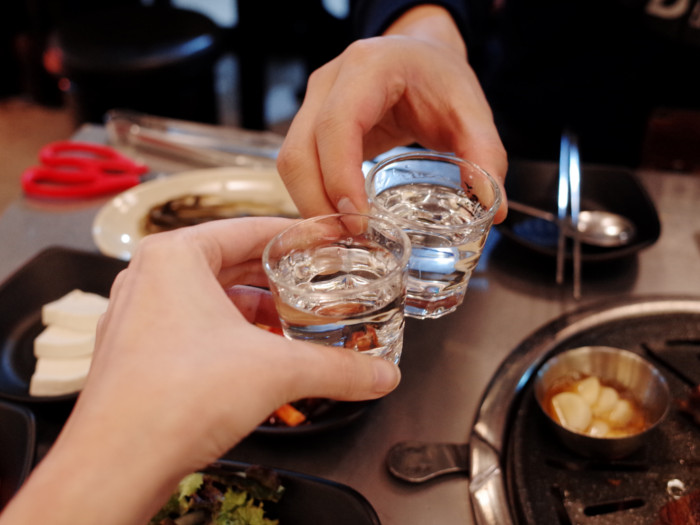Soju is a popular Korean alcoholic beverage that is distilled from rice. It is the drink of choice in Korea, China, and Japan.
What is Soju?
A clear, almost tasteless liquor, soju has about half the alcohol of vodka, clocking in on average between 24-30% alcohol. Traditionally, it has been distilled with rice, but manufacturers now use several alternative starches, such as tapioca or wheat. No matter what starch is used, due to the distillation process, this form of liquor is always gluten-free. [1]
Types of Soju
There are three types of this alcohol, including the following:
- Distilled: The traditional variety is made through distillation.
- Diluted: Diluted forms are cut with water to lower the alcohol content, making it easier to drink.
- Flavored: Flavored varieties are mixed with fruit juice, and is also referred to as cocktail soju. [2]

Soju is a traditional Korean spirit that is best served cold and neat. Photo Credit: Shutterstock
Nutritional Information
On average, this type of liquor contains around 540 calories in one 360 milliliter bottle and contains roughly 20 grams of carbohydrates.
Benefits of Soju
The benefits of drinking this unique eastern alcohol range from stroke prevention to ear health.
- Researchers have found that at least one drink of this alcohol per day may help prevent strokes. [3]
- Mixing this liquor well with water is known to be taken to help with vomiting and other digestive system problems.
- Externally, this alcohol may be used to help dissolve ear blockage.
- A mixture of soju and salt can be taken to relieve chest pain, coughing, swelling, and inflammation.
- This strong liquor is also recommended as a possible treatment for diarrhea and excretory system issues.
However, these health claims are not backed by science and most of them are folklore remedies. Moderate consumption is key. Alcoholism and binge drinking is detrimental to your overall health and can undo any possible good things that moderate amounts can impart.
Risks & Side Effects
Overconsumption of soju can lead to liver damage, and other issues associated with an excessive intake of alcohol.
According to the Centers for Disease Control and Prevention, people who should not drink alcohol include women who are pregnant, individuals younger than 21 years of age, and people who are recovering from alcoholism or cannot control the amount they drink. Also, it should be avoided by people who are planning to drive or any other activity that required focus and skill. However, different countries have different rules on alcohol purchase and consumption. [4]
How to Make Soju?
Let’s take a look at the process of brewing soju.

Homemade Recipe to Make Soju
Ingredients
- 2 cups of white rice
- 4 cups of cold water
- 1 packet of yeast
- 8 tbsp of Nuruk enzyme (specifically used for making rice wine)
- 2 cups lukewarm water
- 4 tbsp sugar
Instructions
- To brew your own soju, you should first soak 2 cups of white rice in water for one hour, then steam.
- Once cooked, place the rice in a sealable container and add 4 cups of cold water, yeast, and 8 tablespoons of Nuruk enzyme, which is sold specifically for making rice wine.
- Stir the mixture twice a day for a week, then let it sit undisturbed for two weeks.
- When ready, strain the mixture, and pour two cups of water through the strainer into the liquid.
- Lastly, dissolve 4 tablespoons of sugar in your beverage and store it in a bottle.
Notes
Soju vs. Sake vs. Vodka
- This alcohol is made through the distillation of starches, such as rice or wheat, making it more akin to liquor. It has a slightly higher alcohol content than sake, averaging about 24%.
- Sake is made through the fermentation of rice, similar to how beer is made. The average alcohol content of sake is 17%.
- Vodka is also distilled from fermented grains, but typically has a much higher alcohol content of at least 40%.
Uses of Soju
- Drink: This is a common, popular drink in Southeast Asia, and is usually consumed with food or meals. [5]
- Cleaner: It is also used externally as a topical disinfectant and cleaner, due to its relatively high alcohol content.
